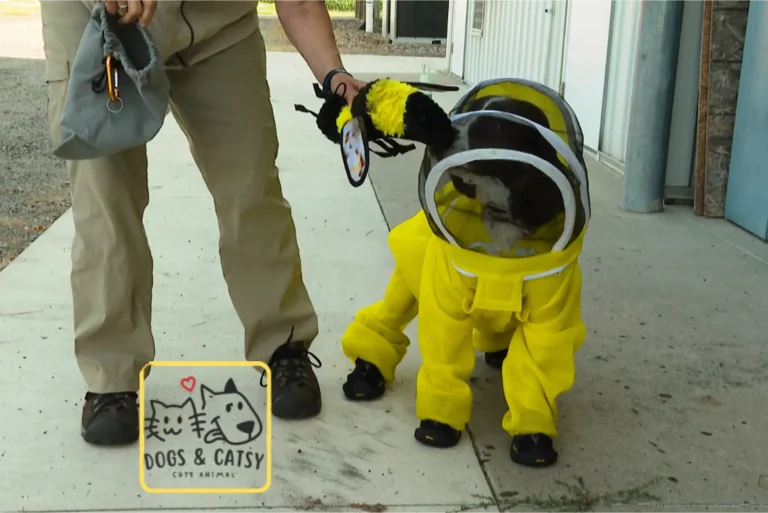What Happens If Your Dog Eats Frosting? Read A Vet’s Advice

Your dog’s birthday is coming up, and you’re eyeing that cupcake with creamy frosting. Those puppy-dog eyes are practically begging for a taste. It’s natural to wonder – can dogs have frosting?
The quick answer is that while a tiny lick of plain frosting likely won’t poison your pooch, traditional frosting is not safe or healthy for dogs.
Let’s explore why that is, what happens if a dog eats frosting, and how to treat your furry friend with safer “doggy desserts” instead.
Can Dogs have Frosting?
No, dogs should not have frosting. Traditional frosting contains ingredients like sugar, fats, milk, and raw egg whites that can be harmful to their health, potentially leading to digestive issues or other health problems.
Instead, offer dog-friendly treats specifically made to meet their dietary needs. These alternatives ensure your pet enjoys a safe and tasty treat while staying happy and healthy.
Also Read: Can Dogs Eat Spoiled Meat?
Why Dogs Love Frosting (But Shouldn’t Have It)
Dogs have a notorious sweet tooth. The rich smell of sugar and butter in frosting can be irresistible to them. You might have noticed how dogs eagerly sniff around desserts – frosting, with its sweet taste and creamy texture, is especially tempting. But is frosting safe for dogs? Unfortunately, no. Regular cake frosting is loaded with ingredients that can harm your dog’s health.
Here’s why frosting and dogs don’t mix well:
- Too Much Sugar: Most frostings are basically sugar paste. Dogs’ bodies aren’t built to handle a sugar rush. Excess sugar can upset your dog’s stomach and throw off their digestion. Over time, it leads to dental problems (cavities and gum disease) and unhealthy weight gain that strains the body.
- Unhealthy Fats & Dairy: Frosting is often made with butter, cream, or milk. These fatty dairy ingredients can give dogs diarrhea or vomiting because many dogs are lactose intolerant (they can’t properly digest milk). High-fat foods like buttercream can even trigger pancreatitis, a serious inflammation of the pancreas.
- Empty Calories: Frosting has zero nutritional value for dogs. Filling up on sugary frosting means your pup is getting a bunch of calories but no beneficial nutrients. This can lead to obesity and even diabetes over time.
- Artificial Additives: Many frostings have food colorings, flavorings, or preservatives. These additives don’t directly poison dogs, but they’re foreign to your pup’s system and can cause allergic reactions or hyperactivity in some cases. It’s just more stuff their body doesn’t need.
Bottom line: Dogs might want frosting, but their bodies won’t thank them for it. Next, we’ll look at something even more dangerous – certain frosting ingredients that are outright toxic to dogs.
Beware: Frosting Ingredients That Hurt Dogs (Reference Table)
All frosting is not made equal. Some cakes and frostings contain specific ingredients that can make your dog very sick. Even a small amount of certain substances can be poisonous – or even deadly – to a dog. Before you let your pup anywhere near that cake, check this reference list of harmful ingredients commonly found in frostings and desserts:
| Chocolate (Cocoa) | A sugar substitute is extremely toxic to dogs. Triggers insulin release leading to hypoglycemia (low blood sugar), vomiting, loss of coordination, seizures, liver failure, and can be fatal. Often found in “sugar-free” frosting, icing, or peanut butter – always check labels! |
| Xylitol (Sweetener) | A sugar substitute extremely toxic to dogs. Triggers insulin release leading to hypoglycemia (low blood sugar), vomiting, loss of coordination, seizures, liver failure, and can be fatal. Often found in “sugar-free” frosting, icing, or peanut butter – always check labels! |
| Raisins & Grapes | Sometimes used as cake toppings or in carrot cake. Highly toxic – can cause kidney failure in dogs, even in small amounts. Symptoms include vomiting and lethargy, and it can be life-threatening. |
| Macadamia Nuts | Occasionally appear in dessert recipes. Toxic to dogs, causing vomiting, weakness, tremors, fever, and hindlimb paralysis in some cases. Keep frosted cookies with macadamia nuts away from pets. |
| Excess Sugar | Not a poison, but large quantities lead to obesity, dental cavities, and diabetes. Too much sugar at once can also cause diarrhea and stomach pains in dogs. |
| Butter & Cream (Dairy) | High-fat dairy can cause digestive upset (diarrhea, gas, vomiting), especially in lactose-intolerant dogs. Large amounts of rich frosting may even lead to pancreatitis, a painful pancreas inflammation. |
| Raw Eggs | Some homemade frostings (like royal icing) use raw egg whites. The risk of Salmonella bacteria, which can infect dogs, causing fever, vomiting, and diarrhea. Cooking eggs kills bacteria; raw eggs in frosting do not. |
| Alcohol or Coffee | Certain fancy desserts might have liqueur or coffee in the frosting. Alcohol is poisonous to dogs, leading to disorientation, vomiting, and even respiratory failure. Caffeine (in coffee) can cause hyperactivity, elevated heart rate, and tremors. |
(Keep your baking ingredients and finished cakes well out of your dog’s reach. If your pup accidentally ingests any of the above, contact a veterinarian or pet poison helpline immediately.)
Also Read: Is Aquaphor Safe for Dogs?
As you can see, it’s not just frosting sugar that’s the issue – some frosting ingredients are downright dangerous for dogs. A classic example is xylitol toxicity in dogs, which is one of the scariest emergencies vets encounter. Next, let’s talk about what can happen if a dog manages to gobble some frosting and what you should do.
What Happens if a Dog Eats Frosting?
So what if your sneaky pup already licked the icing off a cake when you weren’t looking? A small amount of plain vanilla frosting is usually not life-threatening, especially if it doesn’t contain chocolate or xylitol. Your dog won’t magically drop dead from a lick of birthday cake. However, even a little can make them feel pretty icky:
- Upset Stomach: You might see vomiting, diarrhea, or simply a very gassy, uncomfortable dog. The combination of sugar and dairy in frosting often leads to an upset tummy. This could start a few hours after they eat it and last for a day or two.
- Hyperactivity or Lethargy: A sugar rush can make some dogs unusually energetic for a short time, followed by an energy crash. Others might just feel sluggish and “off” because their digestion is upset.
- Begging for Water: All that sugar and possibly salt can make your pup extra thirsty. Make sure fresh water is available if they have frosting, because dehydration can worsen their discomfort.
- No Immediate Signs: It’s possible nothing obvious happens right away. Don’t assume everything’s fine, though – keep an eye on them for the next 24-48 hours, as some effects (like pancreatitis or toxin reactions) can take a bit to show up.
If your dog ate a lot of frosting or an entire cake, more serious issues can occur:
- Pancreatitis: This is a painful inflammation of the pancreas caused by too much fat. Signs include repeated vomiting, hunched posture, belly pain, and refusing to eat. It’s an emergency and needs vet care.
- Sugar Overload: Large quantities of sugar can cause diarrhea and an imbalance in blood sugar. In rare cases, severe hyperglycemia (high blood sugar) or, if insulin spikes, even low blood sugar might occur.
- Obstruction: If the dog also swallowed things like cupcake wrappers or candles along with the frosting (it happens!), those could cause choking or intestinal blockage.
What To Do If Your Dog Accidentally Eats Frosting
Stay calm and take these steps if your pup got into the frosting jar or polished off a slice of cake:
- Check What They Ate: Identify the type of frosting and ingredients. Was it chocolate frosting? Sugar-free (xylitol)? Vanilla buttercream? Knowing this helps determine risk. Chocolate or xylitol = call a vet right away. If it were plain vanilla buttercream, the risk is lower.
- Estimate the Amount: How much did your dog eat? If it was just a couple of licks, they’ll likely be fine with maybe mild tummy upset. If they devoured a whole cupcake or more, that’s more concerning. Large quantity or unknown ingredients = better to err on the side of calling your vet.
- Watch for Symptoms: Observe your dog closely over the next few hours and days. Look for vomiting, diarrhea, excessive drooling, restlessness, shaking, or weakness. These can indicate distress or toxicity. Take notes on what you see and when.
- Do NOT induce vomiting without advice: Inducing vomiting isn’t always the right move – it depends on what was eaten and when. Consult a vet or pet poison hotline for guidance before trying anything at home.
- Keep Them Comfortable: In many cases, a dog that ate some frosting may just get an upset stomach. Provide plenty of fresh water (they might be extra thirsty). You can offer a small bland meal (like plain boiled chicken and rice) later in the day to help settle their stomach, but only if they’re not vomiting.
- Call the Vet if in Doubt: If you’re unsure or notice any worrying symptoms, don’t hesitate to contact your veterinarian. Veterinarians can offer guidance by phone and let you know if your dog needs to come in for treatment. Time is critical, especially if a toxin like xylitol or chocolate is involved.

Remember, you know your dog best – if they’re acting strangely or you’re simply worried, getting professional advice is never the wrong decision. It’s always better to be safe when it comes to your furry family member.
Next, we’ll shift gears and talk about something happier: how you can include your dog in celebrations with special dog-friendly frosting and treats that are safe!
Safe Frosting Alternatives for Dog Treats
Just because regular frosting is off the menu doesn’t mean your pup has to miss out on all the fun. Pet parents today have gotten really creative with making dog-friendly cakes (“pupcakes”) and frostings. These are often marketed as dog frosting or dog icing, and you can even find recipes online or pre-made mixes at pet stores.
Also Read: Your Pet’s Ultimate Guide
A happy birthday pup enjoys a dog-safe “cake”! Instead of sugary frosting, this little Yorkie got a special dog-friendly treat.
Here are some healthy dog treats and frosting alternatives to consider:
- Peanut Butter “Frosting”: Many dogs go nuts for peanut butter. Spread a thin layer of xylitol-free peanut butter on dog biscuits or a dog-safe cake. It’s creamy and looks like frosting, but it’s just peanuts (make sure the peanut butter doesn’t contain xylitol or too much salt). This is a popular topping for dog birthday treats because it’s simple and canine-approved.
- Yogurt Icing: Plain unsweetened yogurt (especially Greek yogurt) can double as a frosting. It’s tangy, and dogs often enjoy it. You can mix it with a little mashed banana or a dab of peanut butter for flavor. Yogurt contains natural probiotics, which are good for digestion, but be mindful if your dog is very lactose intolerant – use lactose-free yogurt in that case.
- Cream Cheese & Pumpkin: Blend a little low-fat cream cheese with pumpkin puree to create an orange-tinted “frosting.” Pumpkin is great for dogs’ digestion and adds sweetness without sugar. The cream cheese makes it spreadable. Again, use only a small amount and ensure your dog tolerates dairy.
- Mashed Fruit Topping: Dogs can safely eat fruits like bananas, strawberries, or blueberries in moderation. You can mash ripe bananas into a creamy paste or puree some berries and use that as a topping on dog biscuits. It’s like a fruity frosting that’s all-natural.
- Dog-Friendly Baking Mixes: Some specialty pet bakeries and online stores sell dog cake mixes and frosting packets. These often use ingredients like potato starch or tapioca (for frosting texture) and natural color from vegetables. They are formulated to be safe for dogs. If you’re not the DIY type, this can be an easy way to make a “cake” for your dog that looks festive but is safe. (Always follow the directions and check the ingredient list.)
- Carob Instead of Chocolate: If you want that chocolatey look or flavor, use carob powder. Carob is a dog-safe alternative to chocolate. You can mix carob powder into yogurt or cream cheese to make a brown “chocolate” style frosting that won’t harm your pup. Many dog bakeries use carob for dog cookies and cakes.
A good rule of thumb is simplicity: the fewer ingredients, the better. Many dogs are just as happy with a spoonful of plain yogurt or peanut butter as we are with a fancy buttercream. And even these dog-safe frostings should be given in moderation – think of them as a special treat, not a regular part of your dog’s diet.
Real-Life Dog Moments With Frosting
Nothing drives the point home better than real stories. Here are a couple of true-to-life anecdotes from pet owners about their dogs and frosting:
“The Great Cupcake Caper” – Anna’s Story
Anna left a dozen frosted cupcakes on the kitchen counter to cool, only to find her Labrador, Max, up on his hind legs devouring them moments later. Max licked all the vanilla frosting off each cupcake, probably thinking he’d found the jackpot.
Panicked, Anna checked the ingredients – thank goodness, no xylitol or chocolate, just lots of sugar and butter. Max ended up with a very sticky snout and a mild belly ache that night. Anna reported that he had some diarrhea the next day, but was otherwise fine after a checkup. “I learned my lesson about leaving sweets out,” Anna laughs.
“Now I bake him his own doggy cake if I’m making one for us.” Max taught her to keep human treats far from doggy reach!
Also Read: Is Chalk Toxic to Dogs?
“Chocolate Close Call” – Brian’s Story
Brian’s German Shepherd, Rocky, got into a tub of chocolate frosting that was left on the table after a birthday party. Chocolate can be deadly for dogs, and Rocky had eaten quite a bit. Brian noticed Rocky smacking his lips and found the evidence: a chewed-up frosting container on the floor.
In a panic, he rushed Rocky to the emergency vet. The vet induced vomiting and monitored Rocky. Thanks to Brian’s quick action, Rocky pulled through just fine, but it was a scary ordeal. The incident could have been fatal due to the chocolate. Brian now urges fellow dog owners to “treat chocolate like poison if your dog gets into it – don’t wait, get to the vet.”
“Birthday Pupcake” – Sophie’s Story
Not all frosting stories are scary. Sophie wanted her rescue beagle, Daisy, to join the fun on her 5th birthday. Instead of a human cake, Sophie baked Daisy a special peanut butter “pupcake” with a light cream cheese and yogurt frosting (tinted pink with a bit of mashed strawberry).
Daisy absolutely loved it – she gobbled it up and licked the bowl clean. Sophie took adorable pictures of Daisy wearing a party hat with dog-safe cake smeared on her happy snout. “It was a hit, and I felt good knowing it wouldn’t make her sick,” Sophie says.
This real-life moment shows that you can include your dog in celebrations safely by making treats that are meant for dogs rather than sharing sugary human desserts.

The Verdict: Can Dogs Have Frosting?
The answer is clear: regular frosting (the kind on human cakes) is a no-go for dogs. It’s not worth the risk. High sugar and fat can make your pup sick in the short term and contribute to serious health issues in the long run. And if the frosting contains a toxic ingredient like chocolate or xylitol, it can be downright dangerous.
If your dog has already had a lick or two of frosting, don’t panic – a small amount without toxic ingredients will probably just cause minor tummy trouble. Monitor your pup and call a vet if you see anything worrying. Going forward, do your best to keep frosted cakes and cookies out of Fido’s reach (those counter-surfing dogs are crafty!).
The good news is, you can still pamper your pet with yummy treats. Opt for dog-friendly frosting alternatives and treats that we discussed. Your dog can enjoy a special cake made just for them, or simple favorites like peanut butter, without the health hazards.
Frequently Asked Questions
Will a little bit of frosting hurt my dog?
A small taste of plain frosting (like a quick lick off your finger) is unlikely to seriously harm a healthy dog. If it doesn’t contain any toxic ingredients, your dog might experience nothing worse than a minor upset stomach. However, “not deadly” doesn’t mean “good for them.” Even a little frosting is full of sugar and fat, which isn’t healthy. So while a lick probably won’t hurt, it’s best not to make it a habit.
Can dogs eat sugar-free icing or frosting?
No – sugar-free icing is not safe for dogs. It can be even more dangerous. Many sugar-free frostings contain xylitol, a sugar substitute that is extremely toxic to dogs. Xylitol can cause a rapid insulin release, leading to life-threatening low blood sugar and liver failure in dogs. Even sugar-free recipes without xylitol often have other artificial sweeteners or dairy that can upset your dog’s stomach. It’s best to avoid any kind of human icing for your pup, sugar-free or not.
What kind of frosting can dogs eat?
Dogs can have special dog-friendly frosting made from safe ingredients. For example, a little peanut butter, cream cheese, yogurt, or pumpkin puree can serve as a dog-safe “frosting” on a treat. These lack the tons of sugar and dangerous additives found in human frosting. You can find recipes for dog frosting (or buy mixes) that use ingredients like tapioca starch and yogurt – these are formulated for canine tummies. Remember, though, even dog-safe frostings should be given in moderation as an occasional treat.
Is it okay to give my dog a piece of cake without the frosting?
It’s better, but still not great. Most human cake recipes contain lots of sugar, butter, and often baking powder or chocolate – all things that aren’t healthy for dogs. Taking off the frosting removes a lot of sugar and fat, which is good, but what’s left is still not ideal for your pup. A plain piece of vanilla cake (no frosting) likely won’t poison your dog if it’s a one-time small bite, but it can still cause stomach upset due to the sugar, butter, and flour. Dogs don’t need cake as a snack. If you want to give your dog a cake-like treat, stick to ones specifically made for dogs.
My dog ate chocolate frosting – what should I do?
This is an emergency. Chocolate frosting means your dog has ingested chocolate, which is poisonous to dogs. Contact a veterinarian immediately. The darker the chocolate, the more dangerous (dark or baking chocolate in frosting is worse than white chocolate). Symptoms of chocolate poisoning can include vomiting, restlessness, rapid breathing, heart palpitations, or seizures. Don’t wait for symptoms to appear – get professional help right away. The vet may induce vomiting or administer activated charcoal to prevent further absorption of the toxin and provide supportive care. Quick action can save your dog’s life.
Why do dogs get sick from dairy like frosting?
Many dogs are lactose intolerant. This means they lack the enzyme (lactase) needed to break down lactose, the sugar in milk. Frostings made with butter, milk, or cream have a lot of lactose and fat. In lactose-intolerant dogs, eating those can lead to gas, diarrhea, and vomiting. Even for dogs that aren’t severely lactose intolerant, high-fat dairy like butter can cause indigestion or trigger pancreatitis. So, it’s the combination of lactose and fat that makes typical frosting a double trouble for doggy digestion.
Can dogs eat cream cheese frosting?
Cream cheese frosting, while not typically containing toxic ingredients, can still cause an adverse reaction in dogs due to dairy content. It’s essential to keep the serving size to a minimum, as most dogs can’t handle large amounts of dairy without digestive issues.
My dog ate sprinkles
If your dog eats plain sprinkles (without chocolate or toxic ingredients), there’s generally no need to worry. ???? However, it’s best to prevent them from eating sprinkles, as the artificial colors and additives aren’t beneficial for their health.
My dog ate peanut butter
“Peanut butter frenzy!” ???? Dogs can enjoy peanut butter, but stick to natural options without added sugar or harmful sweeteners like xylitol. Peanut allergies are rare, yet if there’s any doubt, it’s best to avoid it. Also, steer clear of peanut butter with macadamia nuts or ingredients unsuitable for dogs. ????
Can dogs eat ice cakes?
“Ice cakes – A chilly treat or a no-go?” ???? Dogs can enjoy a small slice of cake occasionally, but ice cakes often have high sugar and fat levels. Keep portions tiny and serve only on special occasions to make sure treats stay safe and enjoyable for your furry friend. ????
Is whipped cream okay for dogs?
“Whipped cream wonders – is it safe for your pooch?” ???? While not toxic, whipped cream can cause stomach issues like bloating or diarrhea, especially in dogs sensitive to fat or lactose. Some dogs handle it fine, but always consider their tolerance before treating them to a puppuccino. ☕
Can my dog have vanilla frosting?
“Vanilla frosting – A canine delight or danger?” ???? While a small taste of vanilla frosting isn’t immediately harmful, its high sugar content can be risky, particularly for puppies. It’s best to skip sugary treats to keep your dog safe and healthy. ????
Here you can learn more:






